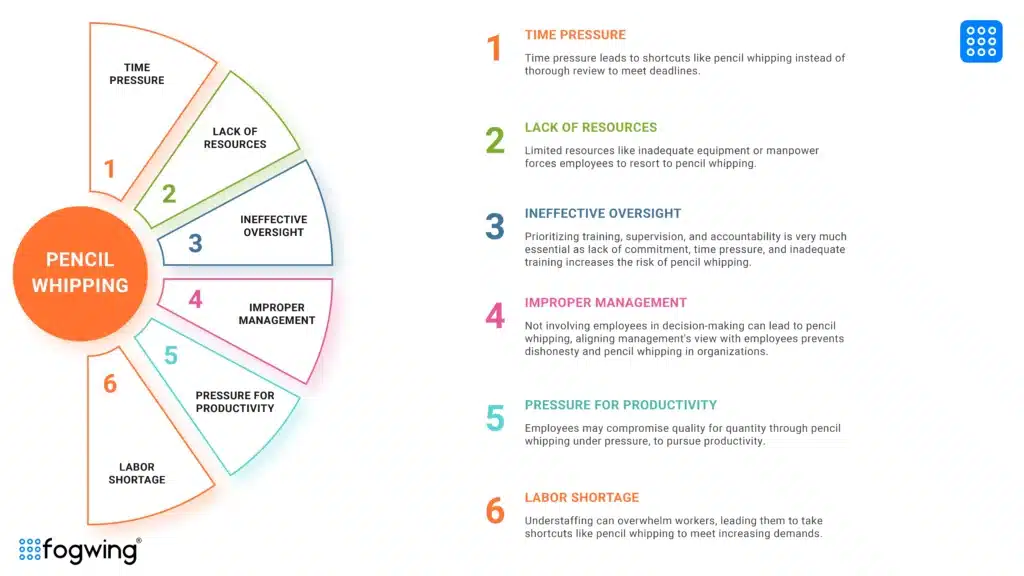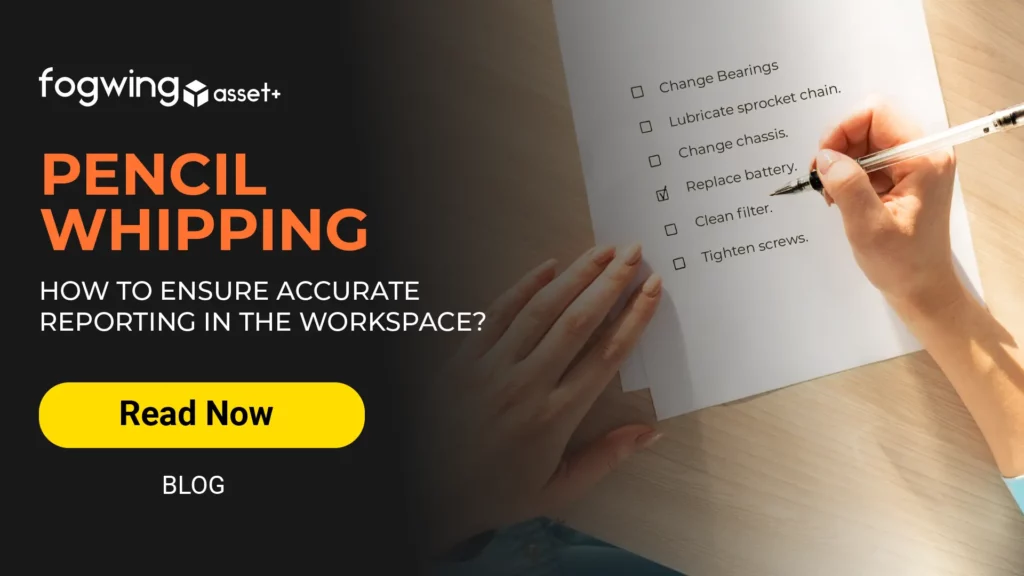It’s common to ditch a trivial task that takes up too much of your precious time. But, with asset maintenance, it is essential to complete every associated assignment, as ditching a single task can lead to a severe wrench. Sadly, the forging of functions has become a concern in organizations while conducting maintenance tasks, described as Pencil Whipping.
This industrial practice has become a significant issue in various sectors, including aviation, manufacturing, and transportation. This blog post explains what pencil whip means, why it’s detrimental to your work process, and how to avoid falling into its trap. Join us as we delve into the dangers of this unethical practice and how to promote a culture of accountability and compliance.
What is Pencil Whipping?
It is about treating paperwork as a mere formality without fulfilling the intended purpose, which can lead to errors and discrepancies. It can ultimately cause issues down the hill. Completing or signing off on a task or inspecting documents, forms, or reports without performing or conducting the necessary action refers to Pencil Whipping. It involves falsely indicating the completion of jobs in an organization.
Organizations are usually pencil whipped due to their lack of knowledge about the subject, pressure to meet the deadline, inadequate training, lack of resources, inadequate training, or to save time. Regardless of the reasons, this shortcut can cost more money and time in the long run for both organizations and individuals. Understanding the seriousness of pencil whip and taking proactive measures to prevent it is crucial. The following sections will explore why this happens, its associated risk, and methods to avoid It.
Reasons for Pencil Whipping

Time Pressure
Time pressure in an organization might urge employees to take shortcuts to finish up their tasks quickly. When employees face strict targets and are burdened with too much paperwork, they choose pencil whipping to save time while meeting the deadline instead of conducting a comprehensive review.
Lack of Resources
In some scenarios, lack of necessary equipment, technical knowledge, or adequate human resources to complete the essential tasks enables employees to choose pencil whip to deal with the limited resources and tremendous workload.
Ineffective Oversight
Employees completing the assigned tasks without commitment to the standards can result in a lack of accountability, time pressure, inadequate training, and increased risk to safety and compliance. In the case of asset maintenance, the maintenance managers can create a checklist to clarify how the technicians should perform the task.
Lack of supervision or liability might lead to the organization being pencil whipped. Organizations must prioritize comprehensive training, effective oversights, and principles of accountability to stop employees from conducting pencil whipping and working diligently.
Improper Management
Aligning the management’s view with the employees is essential, as dishonesty between the management and employees might lead to a pencil whip. Organizations implementing new rules, goals, or directives without considering employees’ thoughts or plans regarding the decisions might lead to management issues.
Pressure for Productivity
In a world where productivity is highly valued, employees need to meet the goals the management sets to succeed; this could result in much pressure on employees. In such sceneries, there might be a compromise in quality over quantity due to pencil whipping.
Labor Shortage
Organizations that employ too few employees can overload the workers with too many tasks, eventually leading them to struggle to meet the organization’s demands, early retirement, or take a break. With the labor storage, overworked employees like maintenance managers or technicians may bypass the assessing and analyzing aspect of workflow, as they need to complete the work at hand.
Whatever the reason an organization is pencil whipped, it can have serious consequences. For one, you may unwittingly agree to something you wouldn’t have if you’d read the fine print. It could be anything from signing away your rights to free speech or privacy to agreeing to pay for damages you didn’t cause.
You also may not catch errors or omissions in the document that could bite you later. So next time you’re tempted to pencil whipping, take a step back and ask yourself if it’s worth the risk. Your future self will thank you for understanding what you’re signing up for.
Risks Associated with Pencil Whipping
Here are some of the risks associated with this unethical practice:
- Poor Quality Products or Services: Without inspections, products or services deemed safe may be defective, faulty, or hazardous, leading to serious quality issues that impact the brand’s reputation, result in losses, and damage customer trust.
- Worker Safety: A Pencil whip can be particularly risky in sectors where employee safety is crucial, such as manufacturing, construction, or healthcare. A lack of inspections can endanger workers’ lives and lead to injuries or fatalities, resulting in legal consequences and hefty fines.
- Regulatory Compliance: Non-compliance with industry regulations or safety standards can result in legal penalties, fines, or even license suspension or revocation. It can also lead to false documentation and non-compliance with regulatory authorities, damaging the organization’s reputation.
- Workplace Morale and Culture: Pencil whipping can lead to a toxic work environment, where accountability and trust are eroded, and workers become indifferent to their responsibilities. Poor morale can lead to high turnover rates, low productivity, and a lack of innovation or growth potential.
A Pencil whip can have severe consequences, both for the individual and the organization. Organizations must understand the risks of being pencil whipped and take proactive measures to prevent it. By implementing a system of checks and balances, ensuring proper training and supervision, and promoting a culture of accountability and responsibility, organizations can avoid pencil whipping and ensure the safety and quality of their products and services.
How to Prevent Pencil Whipping
A Pencil whip can have severe consequences for individuals and organizations, making it essential to take proactive steps to prevent it. Here are some practical ways to avoid it in your organization:
1. Training and Education: Employee training and education are among the most effective ways to prevent your organization from pencil whipped. Employees should be aware of the threats associated with unethical practices and understand the importance of proper inspections and documentation.
2. Accountability and Supervision: Accountability and supervision are essential in an organization to prevent pencil whipping. Managers and supervisors should establish clear expectations and a system of checks and balances to ensure that inspections are conducted correctly and appropriately documented.
3. Use Technology: Technology can help prevent organizations from being pencil whipped by providing real-time tracking and verification of examinations. Electronic signatures, barcodes, and other tracking systems can help ensure that inspections are completed correctly and documented accurately.
4. Regular Audits: Regular Audits should be conducted by an independent party or a dedicated internal team to ensure objectivity and effectiveness. It can help identify a pencil whip and other unethical practices.
By implementing these strategies, organizations can prevent pencil whipping and ensure the safety and quality of their products and services. It is essential to establish a culture of accountability and responsibility to avoid unethical and illegal practices from occurring in the first place.

Training and Educating Employees to Combat Pencil Whipping
Proper training can give employees the skills and knowledge to conduct inspections accurately and ethically. Here are some steps organizations can take to train their employees effectively:
1. Developing an Ethical Culture: Establishing an ethical culture is essential to prevent an organization from being pencil whipped. It is vital to communicate to employees that integrity and accuracy are paramount and that every employee bears personal responsibility for ensuring the accuracy of inspections.
2. Providing Comprehensive Training: Comprehensive training should provide employees with the necessary knowledge and skills to conduct inspections effectively. This training should cover everything from the importance of accurate assessments to the practical aspects of achieving them.
3. Providing Access to Resources: Providing employees with easy access to resources such as guidelines, policies, and procedures can immensely reduce the risk of pencil whipping. Employees should be able to refer to these resources and seek clarification when necessary.
4. Encouraging Feedback and Support: An environment where employees are encouraged to ask questions and give feedback on the inspection process can benefit the organization and employees. Feedback can help identify potential improvement areas, help employees feel supported and heard, and avoid the pencil whip.
5. Regular Refresher Training: Regular refresher training can help reinforce the importance of accurate inspections and keep employees updated on new policies and guidelines. Refresher training can also help identify areas where employees may need additional training or clarification.
Organizations can combat pencil whipping effectively by providing comprehensive training and education and developing an ethical culture. Ensuring that employees understand the importance of accurate inspections and have the resources and support they need to carry out their responsibilities effectively is essential.
Conclusion
In conclusion, pencil whip is a severe problem with far-reaching consequences. It can lead to inaccurate inspections, compromised safety, and damaged reputations. Preventing pencil whipping requires a solid commitment to accountability, clear expectations, feedback and consequences, open communication, regular audits and reviews, and continuous training and education. By implementing these strategies, organizations can ensure that inspections are conducted accurately and ethically and that employees are held to the highest standards of professionalism and responsibility.
The Fogwing Asset+ platform helps organizations from being pencil whipped with the help of automating asset tracking and maintenance tasks. It provides real-time data on asset status, usage, and maintenance needs, eliminating manual record-keeping. It ensures accurate reporting and compliance, minimizing the risk of incomplete maintenance entries.


